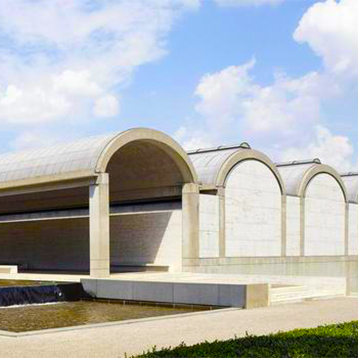The Kimbell Art Museum, Fort Worth, Texas
The Kimbell Art Museum is widely regarded as one of the most outstanding examples of twentieth-century American architecture. Designed by the American architect Louis I. Kahn (1901–1974), the Museum has won wide acclaim since its opening in 1972. In his design for the Kimbell, Kahn emphasized the low, horizontal aspect of the building with separate reinforced concrete vaults, forming two exhibition spaces and a central entrance lobby, and creating three open porticos on the outside. The 120,000 square foot building is widely recognized for the powerful spaces defined by parallel barrel vaults. The spatial rhythm extends to the exterior water-features on the west side of the building, and resolves into a number of paths and garden areas on the grounds.
Kahn’s innovative use of natural light greatly enhances the experience of the art. Kahn envisioned a museum with “the luminosity of silver.” In his design, “narrow slits to the sky” (as he described the skylights) admit natural light, which is dispersed onto the underside of the rhythmic vaults and down the walls. Courtyards, lunettes, and light slots vary the quality and intensity of the light. The building’s gracious proportions, fine craftsmanship, and beautiful landscaping add further to the sense of serenity and restraint.
The 1987 ceremony awarding Kenzo Tange of Japan the prize took place on May 2, 1987 at the Kimball Art Museum. Speakers included representatives of the Kimball Museum, J. Carter Brown, Chair or the Pritzker Prize Jury, Carlton Smith, Secretary to the Jury, Jay Pritzker, founder of the Prize and Kenzo Tange, the 1987 laureate.
